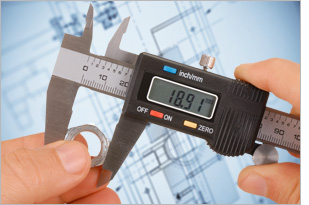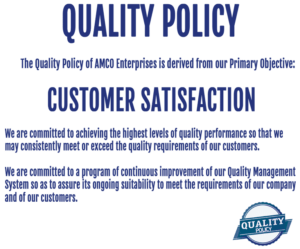Where Quality is more than just a buzzword from the Marketing Department
 Quality has been a top priority at AMCO since long before it became fashionable.
Quality has been a top priority at AMCO since long before it became fashionable.
As the first commercial fastener distributor in the Southwest to establish a comprehensive Quality Assurance Program, AMCO has earned an enviable reputation for consistent quality of both products and services.
Our Quality Management System is ISO 9001:2015 certified, and has been approved to MIL-Q-9858, ISO 10012-1, and ANSI/NCSL Z540-1 for calibrations.
We have been approved for dock-to-stock delivery and/or passport vendor status for each of our major clients that support such programs.
Our entire inventory is fully lot traceable and is labeled accordingly. Certificates of Conformance, RoHS Compliance Certificates, and PPAP (Production Part Approval Process) reports are available upon request. We can provide a custom-designed inspection regimen and/or reporting program to meet any unique quality requirements.

Download our ISO 9001:2015 Certificate, our Quality Policy or our Quality Systems Manual.
RoHS Compliance
Taking care of our clients and our planet
 At AMCO, our first priority is taking care of our clients. But it’s not our only priority. We recognize that taking care of the environment is a responsibility that we all share. And we’re doing our part.
At AMCO, our first priority is taking care of our clients. But it’s not our only priority. We recognize that taking care of the environment is a responsibility that we all share. And we’re doing our part.
Over the past few years, the demand for RoHS compliant products has been on the rise. AMCO has moved to meet that demand by improving our inventory levels of RoHS compliant products, and by putting in place the necessary procedures to ensure that RoHS compliant products and the associated documentation are available to those clients that require them.
Should your order requirements include RoHS compliance, be sure to inform your sales representative at the time of your inquiry. We will be more than happy to accommodate you.
Frequently asked Questions:
What is RoHS?
The Restriction of Hazardous Substances (RoHS) Directive is a European mandate intended to restrict the the use of certain substances deemed hazardous to the environment in the manufacture of electrical and electronic equipment.
What is the difference between RoHS 1 and RoHS 2?
EU Directive 2002/95/EC (RoHS 1) was adopted in the European Union in February, 2003 and became effective on July 1, 2006.
EU Directive 2011/65/EU (RoHS 2) entered into force on July 21, 2011. It was scheduled to be transposed into (European) national laws by January 2, 2013, at which time RoHS 1 was repealed.
RoHS 2 includes changes to the scope of the Directive, includes provisions and methodology for the adding additional substances to be restricted, clarifies rules for granting exemptions, and improves coherence with other EU-Legislation. More detailed information can be found here.
What substances are restricted under the RoHS 2 Directive?
• Lead (Pb)
• Cadmium (Cd)
• Mercury (Hg)
• Hexavalent chromium (Cr 6+)
• Polybrominated biphenyl (PBB)
• Polybrominated diphenyl ether (PBDE)
The RoHS 2 Directive imposes a quantity limit of 0.1% by mass (1,000 PPM) of homogeneous material for each of the substances listed above. The exception is cadmium (Cd), for which the quantity limit is 0.01% by mass (100 PPM) of homogeneous material.
What products are affected by the RoHS 2 Directive?
The RoHS Directive applies to electrical and electronic equipment, and covers all of the components used to manufacture them — including the fasteners. Examples include household appliances, computers, consumer electronic devices, lighting equipment, electric tools, medical devices, etc.
Who is affected by the RoHS 2 Directive?
Technically, the RoHS 2 Directive is binding only in the member nations of the European Union. However, since it applies to covered products imported into EU countries, its impact is being felt around the world. Any company producing products that will ultimately be sold in EU countries must ensure that the products (and therefore all components used in their manufacture) are RoHS compliant.
How does the RoHS 2 Directive impact the U.S. fastener industry?
The manufacturing of industrial fasteners does not generally involve any of the substances restricted under the RoHS Directive. As such, the fastener industry is primarily concerned with the presence of hexavalent chromium (Cr 6+) and cadmium (Cd) used in electroplating. Electroplating is a finishing process commonly used as a means of improving the corrosion resistance and friction coefficients of industrial fasteners and other metal components.
As a practical matter, industrial fasteners are generally considered to be compliant with both RoHS 1 and RoHS 2 if they:
• Are not cadmium plated
• Are not zinc plated
– OR –
• Are zinc plated using a hexavalent chromium free plating process
